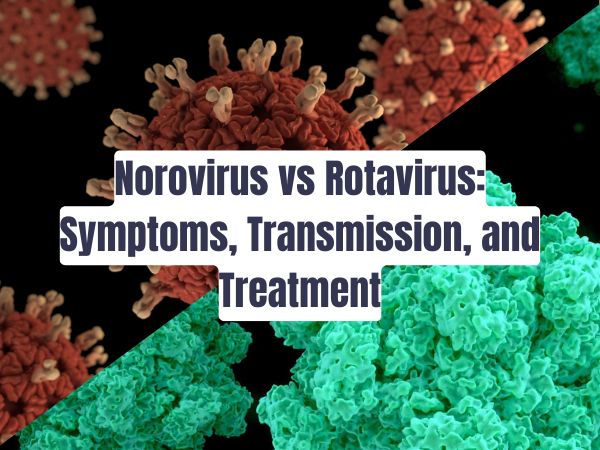Norovirus vs rotavirus are the viral entities known to cause acute viral gastroenteritis, or as it is called, stomach flu. The infection is severe and causes nausea, vomiting, diarrhea, abdominal pain, as well as fever. According to the Centers for Disease Control and Prevention (CDC), each year, approximately 900 people die from norovirus infection while up to 60 deaths have been reported due to rotavirus in the United States.
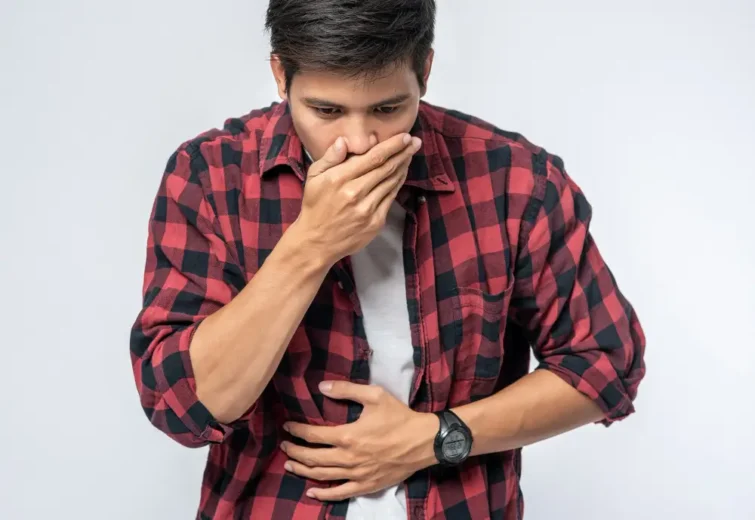
Norovirus vs rotavirus is responsible for stomach flu
Considering the dangers of norovirus vs rotavirus infections, let us dive into what each of these viruses is, how they get transmitted, and what can we do to treat the infections if we already have them.
What is Norovirus?
Norovirus is a highly contagious microbe that is responsible for causing severe inflammation in the stomach as well as in the intestines. As a result, the person feels nauseated and experiences severe abdominal pain followed by vomiting and diarrhea.
The incubation period of norovirus is between 12 to 48 hours. This means that once the virus has entered your body, it will take up to 2 days to show symptoms. Norovirus infections are common among all age groups.
Norovirus has 3 types that infect humans. These include G1, G2, and G4 viruses which can be further divided into more than 25 subtypes.
Symptoms
Between norovirus vs rotavirus, the norovirus symptoms include the following:
- Nausea
- Vomiting
- Stomach cramping and pain
- Abdominal pain
- Watery diarrhea
- Low-grade fever
- Body pain
- Muscle pain
- Headache
- Dehydration
- Loss of appetite
- Decreased urinary output
- Dizziness
- Dry mouth
- Fatigue
Despite looking severe, the symptoms of norovirus are far less severe than those associated with rotavirus infections. Moreover, these symptoms can last for up to 3 days after which they subside sometimes even without treatment.
Transmission
When it comes to the transmission of norovirus vs rotavirus, a similar pattern has been observed in both. Norovirus gets transmitted from person to person as the virus is highly contagious. In addition, transmission through contaminated surfaces as well as contaminated food and water is also possible.
Keep in mind that the virus has to enter your digestive tract via your mouth to make you sick. This usually happens when you touch contaminated surfaces and then put your hands in your mouth. As a preventive measure, it is advised to always wash your hands before having a meal.
If there is an infected person in your vicinity, it is important to maintain a distance to reduce the risk of contamination. Direct exposure without taking any preventive measures can help the virus to transmit into your body.
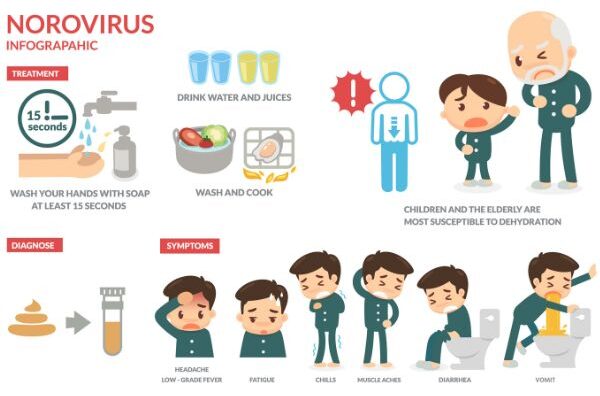
Symptoms, diagnosis, and prevention of norovirus infection
Treatment of Viral Infection
Being a viral infection, both norovirus vs rotavirus should be treated symptomatically as there are no effective antiviral antibiotics available for their treatment. In this regard, the following measures should be taken if you have been infected with norovirus:
Take Rest
The first thing you need to do in case of a norovirus vs rotavirus infection is to take ample rest. Try to sleep for as many hours as you want so that the body can work on eliminating the disease-causing agents.
It is also important to take some time off from school or work. Minimize socializing to prevent the transmission of norovirus infection.
Drink Plenty of Fluids
As the norovirus infection is often associated with dehydration, consuming more water and other fluids can help prevent it from worsening. You can drink hot tea, warm water with honey and lemon in it, or hot water with ginger.
Consuming fresh fruit and vegetable juices of your choice is also a good option. In addition, you can also drink bone broth. Moreover, oral rehydrating solutions (ORS) can also be consumed.
Focus on Your Diet
When we are in a weak physical state due to an infection, it is difficult to consume food. However, not eating anything at all can further weaken the body. Therefore, taking small meals of your choice at least 3 times a day is necessary.
You can consume a BRAT diet which includes bananas, rice, applesauce, and toast. Soaps are also a great option. However, there is no restriction on what to eat and what not to eat. You can eat whatever you can keep down.
For taking in some good bacteria, foods like yogurt, kimchi, or kefir should be preferred.
Take Necessary Medications
For diarrhea associated with norovirus infection, the use of over-the-counter antidiarrheal medications such as Imodium (loperamide) is recommended. In addition, Pepto-Bismol (bismuth subsalicylate) can also be taken. You can also take probiotics for your gut health as these can also help manage diarrhea.
You should always consult a healthcare provider before starting a medication. For this purpose, you can contact your healthcare provider or a pharmacist in a nearby pharmacy.
Take Intravenous Therapy
If your symptoms do not improve even after adopting all of the above-mentioned measures, it is best to consult a healthcare provider who can give you an intravenous (IV) fluid therapy for replenishing the lost electrolytes.
Prevention of Norovirus Infection
Infections like norovirus vs rotavirus can be prevented easily by taking small measures related to your hygiene. These include the following:
- Washing your hands for at least 20 seconds after using the bathroom can reduce the risk of infection transmission.
- Wash your hands after changing a diaper.
- Always make sure that your hands are clean before preparing a meal.
- Use soap and water for washing your hands as alcohol-based sanitizers are not much effective against norovirus.
- Avoid consuming food from places where there is a possibility of contamination.
- Always use fruits and vegetables after a thorough wash.
- Never consume seafood raw. Rather, cook it thoroughly.
- Using gloves and a mask can help prevent norovirus transmission while being outdoors.
- While traveling, take necessary protective measures to cover your mouth and wash your hands whenever possible. Only consume food that is fully cooked in a clean environment. Avoid drinking cold beverages. Rather, prefer warm drinks.
Remember that prevention is our only option as there is no available vaccine for norovirus.
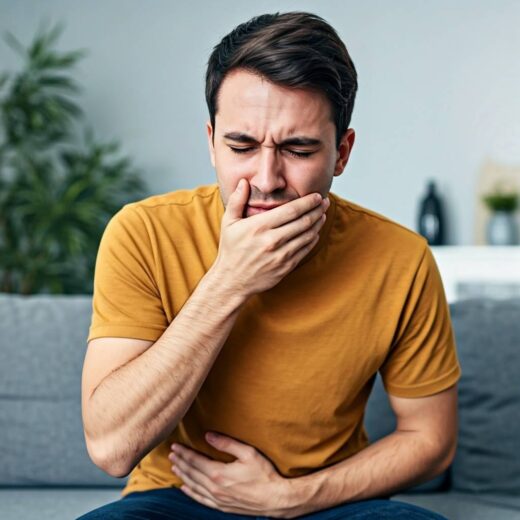
Nausea and abdominal pain are common with both norovirus vs rotavirus
What is Rotavirus?
Rotavirus is an infection-causing entity that affects the gastrointestinal tract leading to its swelling and irritation. As a result, symptoms like nausea, vomiting, and severe diarrhea appear. These issues can last for up to 2 to 3 days.
As for the incubation period between norovirus vs rotavirus, the latter starts showing symptoms after 3 to 8 days of the viral transmission. Infants and young children under the age of 5 are most affected by rotavirus infection, especially during the winter and spring seasons.
The word “rotavirus” is a combination of two words i.e. “rota” and “virus”. “Rota”, in Latin, means a “wheel” which indicates the circular appearance of the viral entity.
Symptoms
Between norovirus vs rotavirus, the rotavirus infection has been associated with the following symptoms:
- Nausea
- Vomiting
- Abdominal or stomach pain
- Severe diarrhea which is watery in appearance
- Infrequent urination
- Dizziness
- Dry mouth
- Extreme tiredness
- Fever
- Dehydration
- Loss of appetite
- Sunken eyes

Rotavirus infections are common among infants and small children
Transmission
The most common transmission pattern of rotavirus is that it gets transmitted from one person to another. The virus gets out of the body of an infected individual and enters a healthy person. After its incubation period, the disease symptoms become prominent. Apart from this, rotavirus spreads in the following ways:
- Rotavirus is also spread from contaminated objects which include doorknobs, toys, toilet seats, etc.
- Contaminated food or water is also another way of transmitting rotavirus to children.
- Rotavirus is also an airborne infection which means it can be caught from the droplets related to an infected person released upon sneezing and coughing.
- Between norovirus vs rotavirus, the rotavirus can also get transmitted through the stool of an infected person i.e. via the fecal-to-oral route. When children touch the stool and then touch their mouth, the virus gets transmitted to their digestive tract.
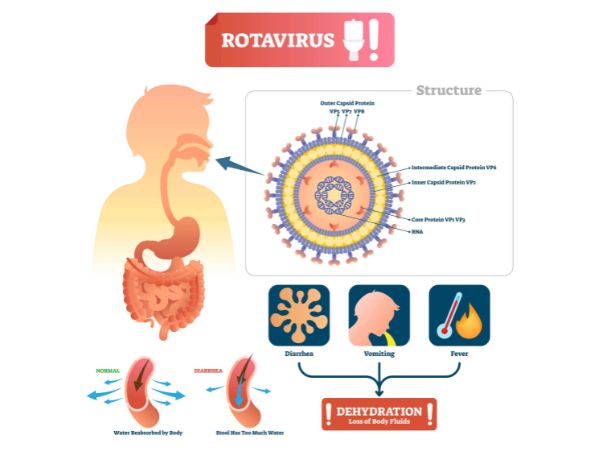
Symptoms of rotavirus infection
Treatment of Rotavirus Infection
As both norovirus vs rotavirus are caused due to viruses, there are no antibiotics that can help with the disease. Generally, the symptoms should go away after a few days i.e. about 7 days. The important thing is to keep the child hydrated as dehydration can become life-threatening. Here are some of the home-based treatment options for rotavirus:
- Feed your sick child with small portions of food more frequently.
- Make sure your child takes enough fluids to prevent severe dehydration.
- Administration of electrolytes to replenish the lost minerals due to vomiting and diarrhea is also an essential step. For this purpose, the use of oral rehydrating solutions (ORS) is recommended.
- For the management of fever associated with the infection, use acetaminophen (Tylenol). The administration of aspirin is not recommended.
- Keep your child at home and let them rest. Prevent healthy kids from staying too close to the infected child so that the risk of person-to-person transmission is reduced.
Prevention of Rotavirus Disease
For the prevention of rotavirus infection, the essential steps regarding hygiene should be taken. In this regard, adopt the following measures:
- Wash your child’s hands after using the bathroom.
- Washing hands before eating is also essential.
- You should also wash your hands after changing a diaper or helping your child in the bathroom.
- Clean and disinfect toilets frequently.
- Make a habit of thoroughly cleaning the surfaces which are touched frequently.
- It is also important to maintain good ventilation within the house.
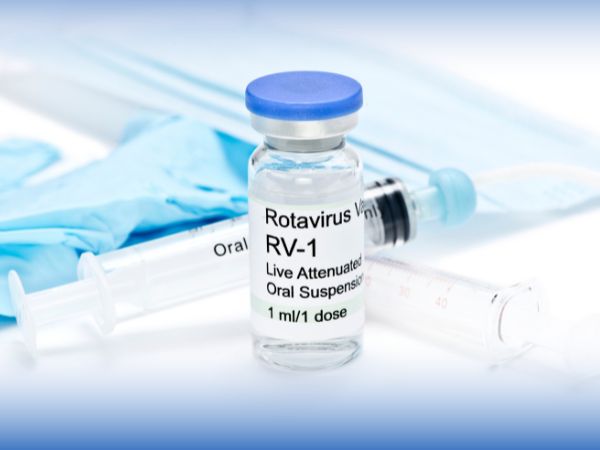
Rotavirus infections can be prevented by the administration of vaccine
Rotavirus Vaccination
Apart from taking necessary measures to protect your child from getting infected with rotavirus, it is also essential to administer a rotavirus vaccine. At present, there are two vaccine options available:
RotaTeq
As per the CDC, RotaTeq or RV5 vaccine is administered in 3 doses at 2, 4, and 6 months of age.
Rotarix
Rotarix or RV1 is another rotavirus vaccine that needs to be administered in 2 doses i.e. at 2 and 4 months.
The safety as well as the efficacy of these vaccines has been thoroughly evaluated. The CDC has reported that every 9 out of 10 people as well as every 7 out of 1 children will stay protected from rotavirus after vaccination.
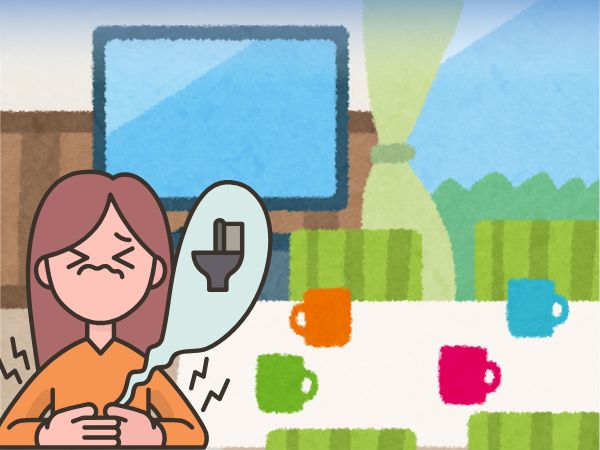
Both norovirus vs rotavirus infections cause frequent bathroom visits after food consumption
The products needed for the diagnosis and management of norovirus vs rotavirus mentioned in this article, along with many other medical supplies, can be purchased from Health Supply 770, a reliable name when it comes to medical products. They have a 30-day money-back guarantee and provide your products to you in the shortest possible time. Click the link at the end of the article to check the wide range of medical products for the management of norovirus and rotavirus infections.
Conclusion
Norovirus vs rotavirus are two different viruses associated with commonly occurring gastrointestinal infections that cause inflammation in the gut. The affected person feels extremely weak and sick due to frequent vomiting and defecation. Being viral disorders, norovirus vs rotavirus cannot be treated with antibiotics. Therefore, home-based measures need to be taken for recovery.
Both norovirus vs rotavirus affect people from all age groups but young children below the age of 5 are most affected by rotavirus. If care is not taken, both of these infections can cause severe dehydration which can then become life-threatening. Therefore, preventive measures as well as treatment should be started as early as possible.
For purchasing top-quality medical goods from different brands for the management of norovirus vs rotavirus, reliable vendors like Health Supply 770 should be approached. They ensure the provision of quality products along with satisfactory services.
Click To Buy from Health Supply 770
30649 CLOROX BROAD SPECTRUM QUATERNARY 32OZ, CS9
MCKESSON MEDSURG 50-66160 WIPE, GERMICIDE LG 6″X6.75″ (160/BX 12BX/CS)
Diversey® Oxivir® TB Wipes (5388471) CS
References
https://www.cdc.gov/pinkbook/hcp/table-of-contents/chapter-19-rotavirus.html
https://www.cdc.gov/rotavirus/vaccines/index.html

PhD Scholar (Pharmaceutics), MPhil (Pharmaceutics), Pharm D, B. Sc.
Uzma Zafar is a dedicated and highly motivated pharmaceutical professional currently pursuing her PhD in Pharmaceutics at the Punjab University College of Pharmacy, University of the Punjab. With a comprehensive academic and research background, Uzma has consistently excelled in her studies, securing first division throughout her educational journey.
Uzma’s passion for the pharmaceutical field is evident from her active engagement during her Doctor of Pharmacy (Pharm.D) program, where she not only mastered industrial techniques and clinical case studies but also delved into marketing strategies and management skills.










